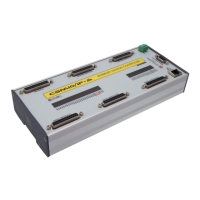5. Recommendations and drives selection (motors drives)
Choosing drives to work under CSMIO/IP-A control - first of all - you should make sure that they can be
controlled by analog signal +/- 10V and that the drive has encoder input in differential 5V standard. It is
also possible use double feedback - then we connect linear encoders mounted on machine's axes and
encoder outputs from drives we leave free.
When you already have a manufacturer in mind and drive model you must choose its power. It is not that
easy. To weak drive will reduce your machine operation capacity and to strong will increase your costs
unnecessarily. Some manufacturers of drives/motors provide special applications that help to choose the
drive power. Users that do not have too much experience can use the examples below to get familiar with
this subject.
• Easy XYZ plotter (e.g. plasma cutter), low acceleration (400mm/s
2
), linear bearings, drive on
toothed bars, gear: 5mm feed/motor rev. Max velocity: 15m/min.
o X axis drive (gate) 2 x 0,2kW (slave axis)
o Y axis drive 0,2kW
o Z axis drive 0,2kW
• XYZ Milling plotter with movable table (e.g. plexi-type materials cutting etc.), acceleration
(700mm/s
2
), linear bearings, drive on ball screws, gear: 10mm feed/motor rev for X and Y ax-
es, 5mm feed/motor rev for Z axis. Max. velocity: (XY) 30m/min.
o X axis drive (table) 1,2 kW
o Y axis drive 0,7kW
o Z axis drive 0,7kW
• Lathe for steel treatment, acceleration (500mm/s
2
), prism bearings, drive on screws, gear:
5mm feed/motor rev. Max. velocity 15m/min.
o Z axis drive 2,2 kW
o X axis drive 1,2kW
In the examples above there are rather minimal power values. You need to remember that pulleys should
be selected this way that maximal working feed rate corresponds to nominal motor revs. If the motor has
nominal 3000 RPM, and in practice it will revolve maximally 1000 RPM - because of for example drive
screw vibrations - then 66% of potential drive power will be wasted... Moreover - incorrectly selected gear
will cause bigger problems with PID tuning. So it's really worth to spend some time on the mechanical
parts to get good parameters of our machine working at the end.
Temporarily the motor can have higher RPM than nominal but I suggest keeping the "surplus" for shift
motions.
In case of old machine retrofit it is worth to consider drives replacement, even if they seem to work fine at
first sight. Demagnetized motors and dried up capacitors may decrease working quality and after short
period of time may cause machine failure.
CS- Lab s.c. – CSMIO/IP- A - CNC controller
Page 40

